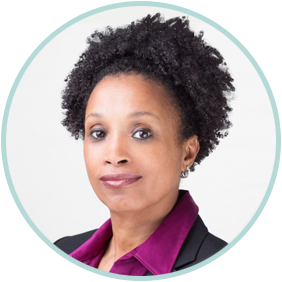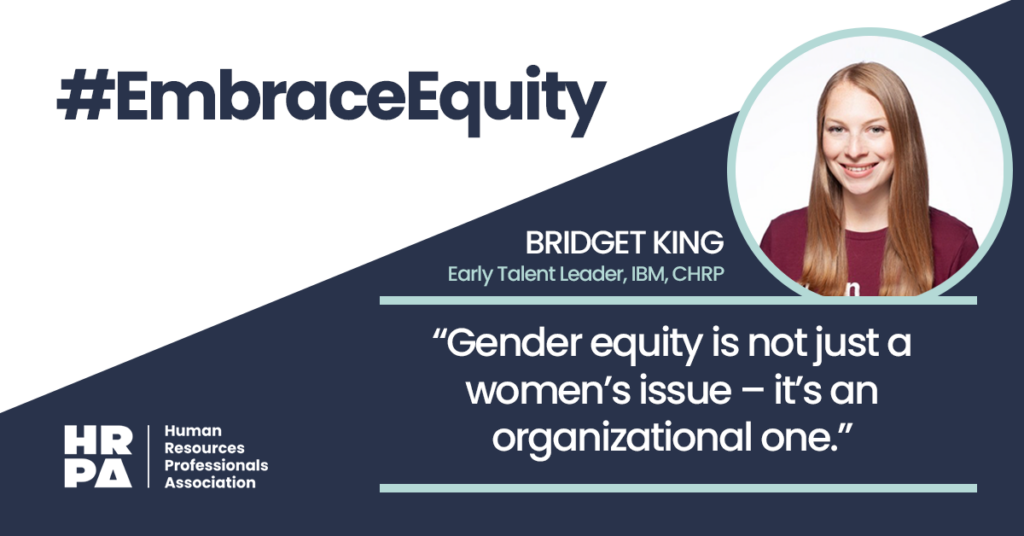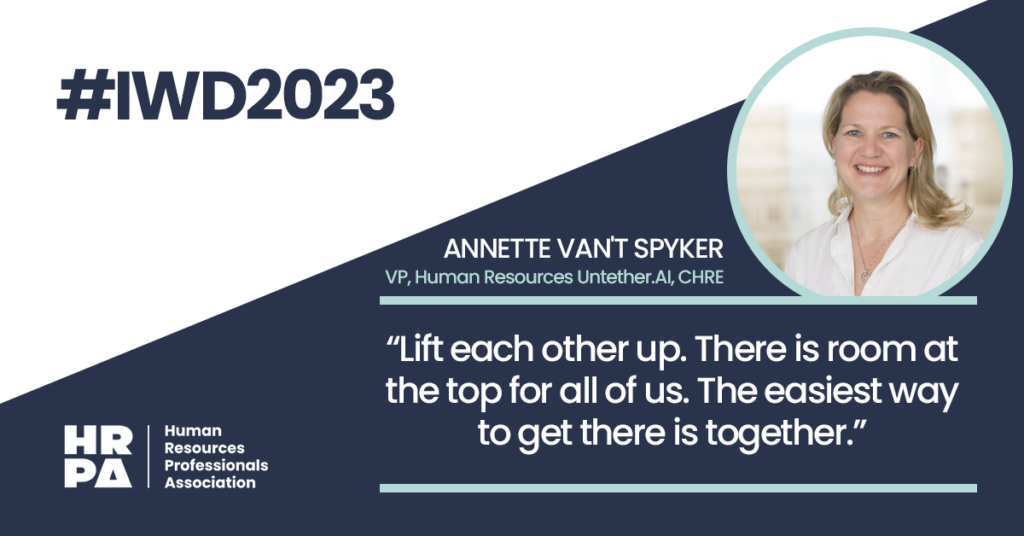HR, Women & Work
International Women’s Day (IWD) is a global celebration of the social, economic, cultural, and political achievements of women. For HRPA, this day also marks a call to action for accelerating gender parity and gender equality in the workplace.
HRPA is acknowledging the Government of Canada’s 2023 IWD theme, #EveryWomanCounts. We believe all women deserve to be heard and taken seriously at work, including in the economic, social, and democratic spheres. We are also acknowledging the global International Women’s Day theme, #EmbraceEquity. To effectively empower women in the workplace, equitable measures and strategies need to compensate for historical and social disadvantages that prevent women from otherwise achieving full equality.

The gender-wage gap persists in HR, with men reporting an average salary that’s 15% higher than women.

Canadian women spend an avg. of 3.9 hours per day on housework compared to 2.4 hours per day for men.

Only 18% of workers have seen improvement on EDI in the workplace, while nearly half report little to no change.*
Q&A with 3 Women in HR
Find out what this year’s International Women’s Day means to three incredible HRPA members and learn from the insights they share on women’s challenges in the workforce.
1. What does “Every Woman Counts” mean to you as a woman in HR?

Bridget King
This year’s theme is a reminder that we all matter and should have a voice at the table. As HR professionals, we have a responsibility to advocate for those facing barriers and look beyond creating equal opportunities, and instead establish equitable opportunities. We need to help leaders recognize that equity isn’t just a nice-to-have, it’s a must-have.

Ingrid Wilson
For every woman to count, we need to move past equality to equity and inclusion. We need to understand that there is not just one solution to arrive at equity. Whereas equality is a first step, equality is not the same for all women and those who identify as women. We need to ensure that societal and financial barriers are addressed to give all women, and all those that identify as women, the opportunity to succeed and thrive.
As an HR professional we need to also review all programs and policies within the workplace to ensure that we have not inadvertently or intentionally embedded systemic barriers within these programs and polices to prevent women from succeeding and thriving. For example, are our workplace benefit programs equitable for all women and those who identify as women? As HR professionals, we need to step back and build cultural, gender and identity awareness and a better understanding of the actual impact and outcome of these programs and policies on employees, peoples, groups and communities.

Annette van’t Spyker
Every woman has a perspective and life story that is uniquely theirs. In all aspects of society, including and especially business, we need to learn from each other and lift each other up. When a woman doesn’t believe – or is told – their voice isn’t worth listening to and they don’t share their perspectives, insights and experiences, we, as a whole, are worse off. To create a world that is inclusive, considerate of others and open to different viewpoints, we need to make sure that every woman understands that their input matters. Every woman needs to use their voice to make their community – however they define that – a better place.

2. Every woman counts so, every challenge women experience in the workplace should matter too. Read our interviewees' perspectives and insights on some of the obstacles women face in the workplace.
(Please keep in mind that this list is by no means exhaustive and does not include all the issues women must grapple with at work.)
Annette van’t Spyker: Ageism affects everyone but it seems to affect women more than it does men. Often when organizations talk about diversity, it relates to gender or ethnicity, and not age. Highlighting the benefits of a diverse workforce from an age standpoint could help reinforce the benefits of diversity in the workplace as a whole.
Mentoring programs can help tackle ageism in the workplace because they help support a workplace culture where differences are used as opportunities to learn and grow from employees of different ages and experiences.
Annette van’t Spyker: Unfortunately, the gender-wage still exists. In Canada, women make 89 cents on average for every dollar made by a man. To help resolve this, organizations must be transparent. It’s important that they share how tenure, experience, education and other criteria influence compensation to provide a framework for women to build a case around a fair salary for themselves.
Bonus – Negotiation Advice: Anyone negotiating salary should do their homework. This means, research salaries for the same or similar roles at other organizations, articulate the value you bring to the organization and the value other organizations place on the same or similar roles. Facts not only support the case, but they also, provide a level of professionalism and confidence in the discussion and will help everyone stay on topic. Also remember that these discussions don’t always start and finish with one meeting. Be prepared for this to take a few meetings and be professionally tenacious.
Bridget King: Menstrual products are a basic need and are essential to women’s participation in not only work, but society as a whole. Today, one in three Canadians still struggle to afford menstrual products.
Employers have an opportunity to lead by example and break down this barrier to equality by providing access to menstrual products in every workplace. Many companies are now taking this one step further by offering paid menstrual leave for their employees.
Ingrid Wilson: As women, and those who identify as women, it is important to understand that we carry different identity markers. For example, I am Black. I am a woman. I am also a Jamaican now living in Canada. All of these social identities make up who I am — and carry potential bias.
But systemic racism, and a lack of understanding and awareness of identities, cultures, abilities, and beliefs, can lead to pervasive forms of discrimination that can compound to impose barriers on women, and those who identify as women.
To address this issue, HR leaders must build more racially equitable workplaces, which includes addressing all our own unconscious biases. We must also be willing to listen and have difficult conversations with employees, especially those who are people of colour, and eliminate bias from hiring and retention practices.
Bridget King: Research has shown that sexual harassment in the workplace is often underreported due to fear of retaliation, and when it’s reported, it’s often not dealt with effectively.
Employers have a responsibility to implement prevention measures, raise awareness and implement mandatory training for all. Although many organizations may have policies in place, training and awareness may be limited.
Ingrid Wilson: Our society continues to place the majority of caregiving responsibilities — for children, adults, and families — on women and those that identify as women. It’s called “Care-Giver” bias. As a result, women, and those that identify as women, are more likely than men, to make tough decisions to leave or take steps out of the workforce to take care of loved ones.
In fact, women, who are mothers, experience the following consequences of gender bias compared to women and other genders without children:
- Lower compensation
- Fewer opportunities for promotions and leadership roles.
- Fewer opportunities for jobs
Offering flexible scheduling, proper return to work programs (that ease re-entry for those who went on leave), and work-from-home arrangements are some strategies employers can implement to help address this problem.

3. Despite these challenges, International Women’s Day is also about celebrating women. What’s the action or decision in the workplace that you’re most proud of?

Bridget King
The impact of the pandemic was challenging for all of us, but it did lead to a major shift in how employers view the workplace. The transition to a hybrid workplace has been game-changing for women. A 2022 study by Lean In found that when women work remotely, they experience fewer microaggressions and increased psychological safety. Beyond providing more flexibility for working mothers, remote work has become one of the top reasons women choose to join and stay with an organization.

Ingrid Wilson
In one of my corporate roles, my team and I rebuilt a women’s networking program to create a space that would move beyond networking and provide a safe place for development and allyship. It provided an open and interactive environment to lift up all voices and allow women, and those that identify as women, to share experiences.
Allyship was a key part of this program because we were able to get support from other groups, genders, and communities and develop actionable solutions to address systemic barriers preventing all women from rising and thriving in the workplace.

Annette van’t Spyker
I feel very proud to see the success that women who I coached or mentored earlier in their career have achieved today. It is hugely rewarding to me to know that I was a part of their journey and to see them reach their potential. Whether my job was to help them believe in themselves, open doors, or to be a friendly face in the room, knowing that I made an impact is very motivating. Even more motivating is knowing they are doing the same for women in their lives.

Additional Resources
Articles and Resources
- CEO Corner: Flexibility is the Future of Work. Equity Demands It.
- Statistics Canada *
- 2022 Trends Survey*
- Government of Canada: Every Woman Counts
- International Women’s Day: Embrace Equity
- Government of Canada Pay Equity
- Government of Ontario – Workplace Harassment: Investigation by the Employer
- HRPA-CPHR Survey Results are In (Information on the Gender Pay Gap in HR)
- HRPA HR Insights – More Resources for Diversity & Inclusion in the workplace
- Revisit last year’s HRPA International Women’s Day interviews
- Check out more diverse perspectives from women in HR – 5 HR Professionals Share Perspectives on Black History Month
Programs and Events
Follow us on LinkedIn, Instagram, Twitter & Facebook, #IWD2023, #EmbraceEquity, #EveryWomanCounts.